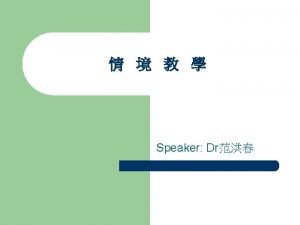Longitudinal Effect of Food Allergy Education on Epinephrine

- Slides: 1

Longitudinal Effect of Food Allergy Education on Epinephrine Availability in Public Schools Dipika Patel MD, Niti Choksi MD, Carla M. Davis MD Baylor College of Medicine, Department of Pediatrics, 2 nd Year Categorical Pediatrics Resident Introduction Increase in Mean Number of IEDs/School 2010 -12 (Background and Purpose/objectives) ØFood allergy is a serious medical condition affecting nearly 6 million or 8% of children 1 with prevalence increasing 50% between 1997 and 2011. 2 p <0. 001 Mean Ø 18% of food allergic (FA) children have had a reaction in school with 28% of all FA fatalities due to anaphylaxis occurring in school. 3, 4 Furthermore, there is a significant disparity in the availability of injectable epinephrine devices (IEDs) in schools with underserved populations. 5 ØGiven all this, and the ultimate possibly fatal consequences of anaphylactic reactions due to poor recognition of signs and/or delayed administration of IEDs, we piloted an interactive education session for school nurses regarding food allergy recognition and management, and sought to increase awareness of the need for IEDs in all schools with a sustained effect for at least 2 years. 2010 -11 2011 -12 Number of IEDs/School significantly increases from 2010 (1. 9) to 2011 (3. 2) Abstract Increased Correlation IEDs and Food Allergic Children 2010 -12 There is a rising prevalence of food allergy (FA) reactions in children with 28% of fatalities secondary to food allergy anaphylaxis occurring on school grounds. 4 One critical marker of poor outcomes from anaphylaxis is delay in epinephrine administration. 6 This is further complicated by a demonstrated disparity of availability of injectable epinephrine devices (IEDs) in schools with underserved populations. 5 The importance of this issue was recognized by President Obama with the School Access to Emergency Epinephrine Act in November of 2013, which provided incentives for states to require schools to stock unassigned epinephrine. 20 2011 -12 15 10 2010 -11 5 We sought to educate school nurses on FA recognition and management, and increase awareness of the need for IEDs in all schools with sustained effect for at least 2 years. To accomplish this, a needs assessment survey was emailed to Houston Independent School District (HISD) elementary school nurses, followed by FA education and annual surveys thereafter. 20 40 Number of Food Allergic Children/School 60 Spearman Correlation: 0. 42 in 2010 0. 82 in 2011 ØThe size of the circle represents the frequency of schools with that number of IEDs and students with food allergies. ØIdeally the correlation would be 1. 0, and the ratio of IEDs to FA child 1: 1, indicating an available IED for each FA child ØIn this case, the correlation coefficient, representing the ratio of the number of IEDs to the number of FA children, nearly doubled from 2010 to 2011 from 0. 42 to 0. 82. There was an increased correlation in number of student-specific IEDs per FA child and a statistically significant decrease in allergic reactions after FA education. In addition, there was a significant difference in availability of IEDs in high versus low SES schools with no significant difference in amount of increase between the two categories. Results supported use of an interactive educational workshop as a model for a country-wide standardized nursing education program for food allergies. Significant Difference In Mean Number of IEDs by SES Both Years Description of intervention/study Difference in increase of IEDs based on SES not significant (p=0. 066) Conclusions ØA single school nursing education session on food allergies §Decreased allergic reactions §Increased availability of IEDs per FA child §Equal effect in high and low SES schools §Sustained the above effect over 2 years ØCan serve as a model for a country-wide standardized nursing education program for food allergies ØAn on-line course is currently being piloted to determine if the effect of education is the same in other populations, including teachers and administrators. References Results 1. Decreased Food Allergy Reactions 2. 3. 4. 5. Significant decrease of FA reactions from 2010 (15%) to 2011 (0%) (p=0. 014) with no significant difference in between 2011 and 2012 (5%) (p=0. 153) 6. National Institute of Allergy and Infectious Diseases, National Institutes of Health. ‘Report of the NIH Expert Panel on Food Allergy Research. ’ 2006. Retrieved from www 3. niaid. nih. gov/topics/food. Allergy/research/Report. Foo d. Allergy. html. Jackson K et al. Trends in Allergic Conditions among Children: United States, 1997 -2011. ‘National Center for Health Statistics Data Brief. ’ 2013. Retrieved from www. cdc. gov/nchs/databriefs/db 10. htm A. M. Branum, and S. L. Lukacs, 'Food Allergy among Children in the United States', Pediatrics, 124 (2009), 154955. S. H. Sicherer, T. Mahr, Allergy American Academy of Pediatrics Section on, and Immunology, 'Management of Food Allergy in the School Setting', Pediatrics, 126 (2010), 1232 -9. Shah , et al, ‘Disparity in the Availability of Injectable Epinephrine in a Large, Diverse US School District’, J Allergy and Clinical Immunology in Practice 2013, DOI: 10. 1016/j. jaip. 2013. 09. 016 Corrected Proof , 23 December 2013 K. J. Simons, and F. E. Simons, 'Epinephrine and Its Use in Anaphylaxis: Current Issues', Current Opinon Allergy Clinical Immunology, 10 (2010), 354 -61. Texas Pediatric Society Electronic Poster Contest

